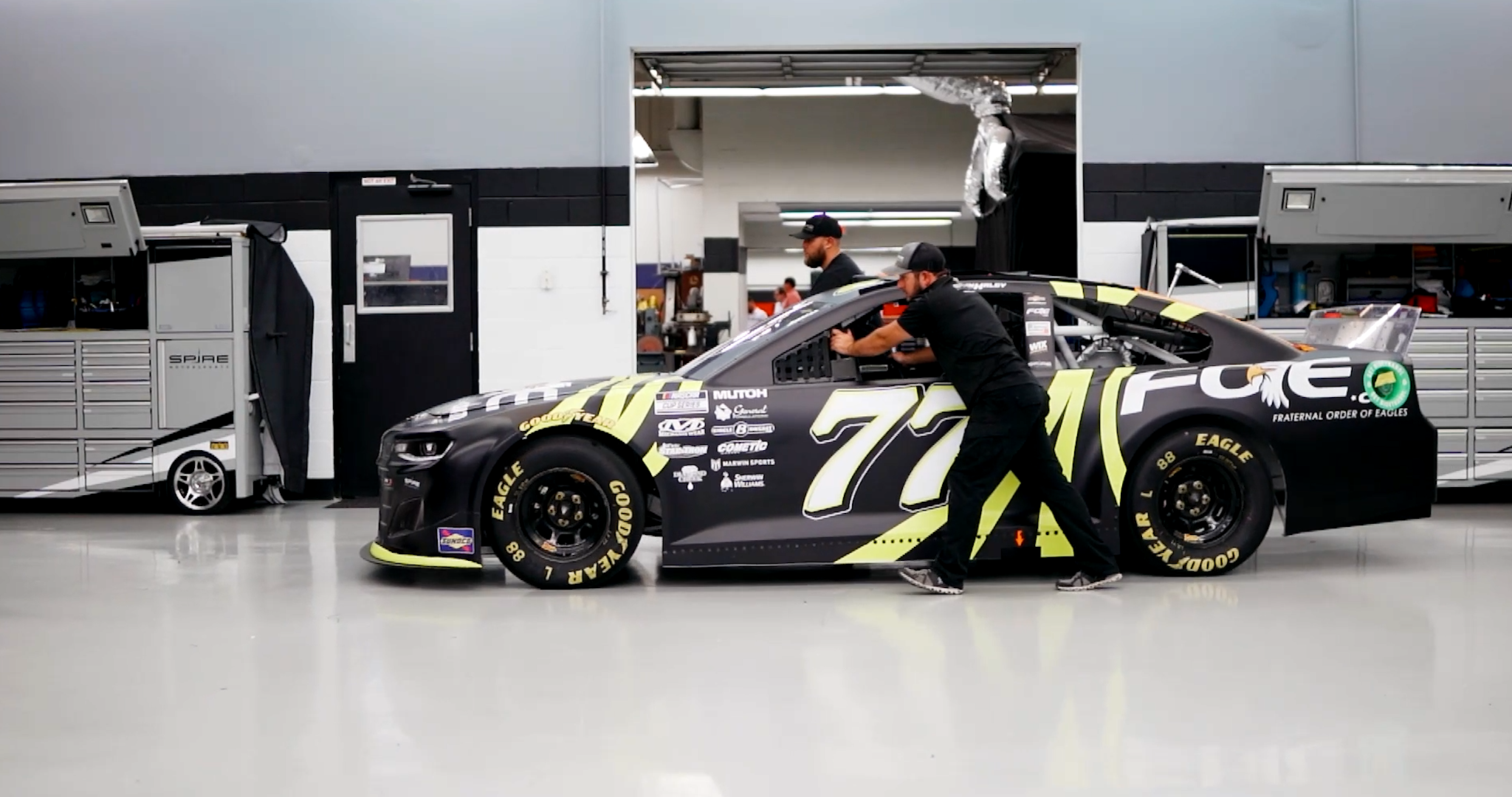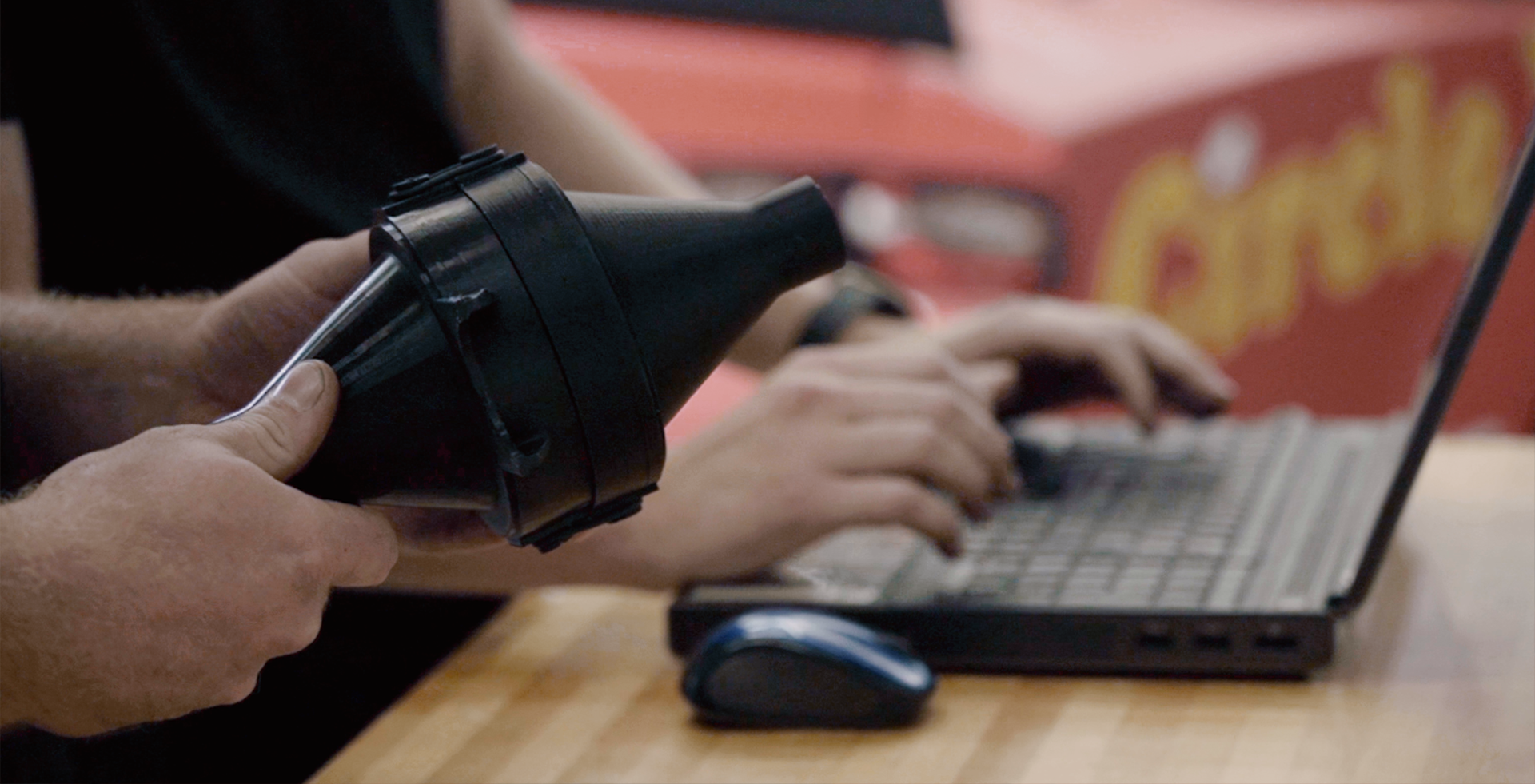Spire Motorsports, a newcomer in the NASCAR Cup Series, raced onto the scene in 2018. Within a year, the team caused one of the biggest upsets in NASCAR history with its first win at the Coke Zero Sugar 400 at Daytona. Since then, the team has been accelerating its efforts on and off the racetrack. Racing the #7 and #77 cars, Spire Motorsports has demonstrated its fortitude, thanks—in part—to the power of its collection of MakerBot METHOD X 3D printers.
“What’s really powerful about METHOD X and 3D printing, in general, is if you need something made and you need it made quickly, it’s ready to go,” said Ryan Kelly, engineer at Spire Motorsports. Kelly oversees the team’s 3D printing activities, in addition to his role as a trackside support engineer and engine mechanic.
With three METHOD X 3D printers at their fingertips, the team continuously prints parts that they need, without having to outsource or purchase from other vendors, teams, or companies. The printers are used regularly throughout the week, 3D printing anything from race car parts and support equipment to impromptu requests from other departments at the team’s parent company, Spire Sports and Entertainment.
Racing 400-500 miles weekly in 36 races during the season, it’s no surprise that the team needs to replace parts on a regular basis, whether it’s from breakage or simply getting worn out from overuse. METHOD X enables the team to remain efficient and keep their workflow going, which is crucial during the grueling NASCAR Cup Series schedule.
“The machines are instrumental to our ability to get things done in a timely fashion, as well as be able to replace parts on-demand. That’s something that is a huge benefit in having the MakerBot METHOD X,” he continued. “Having METHOD X to be able to make a part, designed the exact way that we need, is critical to getting things done in the shop.”

PUTTING A MULTI-PRINTER, MULTI-MATERIAL SOLUTION TO TASK
Spire prints with a mix of ABS, Nylon Carbon Fiber, and PLA for a range of on-car parts, depending on its needs. Unlike traditional heavy materials like aluminium, steel or metal, typically used in their fabrication shop, 3D printing materials enable the team to print lighter weight parts while still maintaining the strength and durability needed for their cars. METHOD X is used for critical parts in the cockpit, under the hood, around the engine as well as outside of the car.

“There are printers out there that have the capability of printing pieces that can be seen on the cars. And that is something that will become bigger and bigger as we continue to move forward with additive manufacturing in the future. MakerBot and their machines like the METHOD X will be able to produce those pieces in the future. They will become part of what we do and what we use on the race cars visibly on a regular basis,” Kelly added.
Some of the behind-the-scenes parts that the team prints include the ECU spacers, shifter knobs, filter housings, cooling ducts, as well other parts for the cockpit. For interior aspects of the cockpit, the team uses ABS while in more extreme environments, such as underneath the hood, in the engine area, in the trunk, or around the track surface, the team uses MakerBot’s Nylon Carbon Fiber, which has strong physical properties and can endure higher heat situations.

“There is just so much heat involved there and those carbon fiber pieces will take a beating to an extent from higher heat and tougher environments,” said Kelly.
Parts like the driver CO2 filter housing, which is part of the driver cooling system, are printed in ABS, PLA, or nylon carbon fiber. While the car has other built-in features to prevent CO2 poisoning, the filter is another crucial element to ensure safer driving. The ECU spacers, used to raise the ECU off the dashboard to make it more accessible to the driver, are also printed in ABS. 3D printing spacers opens up the ability to do offsetting or angled spacers for other purposes.
The cars’ alternator/power steering cooling ducts are printed in nylon carbon fiber. These ducts are attached to the end of hoses that run from behind the front bumper of the car, from the grill inlet, to the power steering cooler and the Alternator. Keeping the alternator and power steering fluid cool is important to prevent failures during the race. The advantage of 3D printing these ducts comes down to available resources, weight, and the production time.

The battery ground housing, a cover where the battery ground cable is bolted to the chassis, is also printed in nylon carbon fiber since it needs to protect the ground cable from getting damaged. This part is 3D printed because of its complex geometries, which is difficult to make by hand, which can lead to an increase in production time, not to mention the weight of it if materials like aluminum or metal are used. 3D printing shortens production time for every car, compared to fabricating multiple parts. For a small team like Spire Motorsports, 3D printing parts saves time and other tasks can be done instead of making all of these different parts.
“The quality of the prints is tremendous. What we have found when we design something in our CAD software and then print on METHOD X is that the tolerances involved with the sizing and the dimensions of those parts and pieces are extremely accurate. What we design on the computer correlates extremely well with what is actually made on the printers. We’re talking about a thousandth of an inch – it is that accurate,” Kelly said.
The team utilizes MakerBot CloudPrint’s remote printing and on-camera features to manage and monitor their prints, while they’re away from the machines or the shop. It enables the team to track and ensure that the prints are going smoothly, while also letting them run interference should a potential issue arise.

Prior to acquiring 3D printers, the team would work with different vendors, including other race teams, to create parts and pieces that they would need. However, as with any outsourced item, they may get parts that don’t necessarily fit properly, per NASCAR’s rules and regulations. Using METHOD X, the team is able to print any type of spacer or shim that they might need to make the parts fit better in certain areas of the car, including inside the cockpit, underneath the hood or around the engine.
“There are different duct and cooling pieces and hoses that we use, and sometimes we may just need something that is a quarter of an inch. And it’s the difference between something fitting and not fitting,” noted Kelly. “With these machines and the different types of materials we have, you’re able to design spacers and shims that allow you to create something that will make other parts fit that aren’t 3D printed and they will withstand the environment that they are in.”


DESIGNING PERFORMANCE PARTS ON DEMAND
The biggest challenge for race teams, like Spire, is having to outsource parts to be machined that can be easily and accurately made on a 3D printer. In some cases, parts received may not be designed to specifications and they may weigh and cost more. Especially if the parts are needed immediately.
“I’ve heard stories from some of the teams we race against, where they have had to make parts and ship them overnight to the race team at the track on a race weekend, when they need it on Sunday morning for a race,” said Kelly. “At a professional level like the Cup series, anything you can do from a performance perspective at the racetrack to keep up with the rest of the field—any way you can find a way to increase speed and performance in these cars, you have to be able to explore those avenues.”
“That’s the biggest benefit of having the METHOD X printers here—and the challenges that could potentially be faced without them. METHOD X allows us to be able to exploit those opportunities where we can gain performance in ways you wouldn’t think about normally,” he continued.

Another concern for Kelly is sustainability. Typically, machining parts can create a lot of material waste.
“You can buy a 4×8 piece of aluminum but only use 3-5 inches of it. Once you shave it all down, you have scrap metal left over. It can be reused and recycled but it doesn’t provide the same efficiency that a 3D printer can—where you can take the materials and build from the ground up, rather than taking something and cutting it down,” said Kelly.
Overall, the team has been able to utilize METHOD X as easily as a desktop 3D printer and print parts “as good, if not even better, than printers that are worth tens of thousands of dollars.”
“They’re very simple and easy to set up and get started and it’s worth it. If you’re having a conversation of whether or not it’s worth putting one of these in your shop, then yes, it is worth it,” Kelly concluded.
Originally published for makerbot.com

